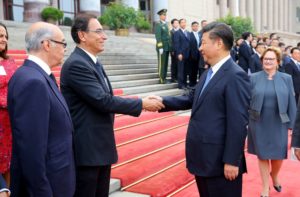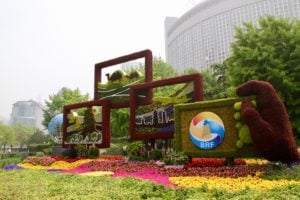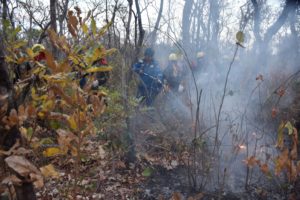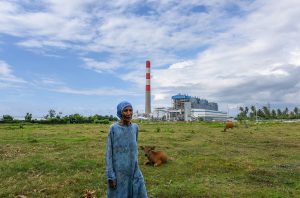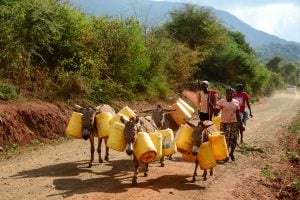Five years after Bolivia’s government awarded construction of the Rurrenabaque-Riberalta highway to China Railway Construction Corporation (CRCC), barely 15% of the project is complete.
Problems plague the Amazon-bisecting road, with local communities and biologists deeply concerned about its impacts. One environmental NGO described it as “the most contentious project in the country.”
The 508-kilometre road, which China’s EximBank funds with a preferential loan, requires a total of US$579.4 million in investment. It is located in the department of Beni, near the Bolivian portion of the largest continuous jungle in the world, both rich in biodiversity and highly fragile.
The road is a disaster…Our costs have gone up
A flagship project of President Evo Morales, who signed Bolivia up to China’s Belt and Road Initative in June 2018, the road will diagonally traverse a portion of the country, serving as a link between the Peruvian and Chilean border areas to the south-west and Brazil to the north-east.

Multiple problems
Dust, mud, traffic jams, and poor signalling have blighted the road over the past four years, according to residents and drivers who frequently travel between Rurrenabaque and the towns of Reyes and Santa Rosa, 95-kilometres north of the capital La Paz.
“We’re the ones who suffer, the ones in transport, because it rains for one day and for a week the road is unusable,” says Carlos Marupa, a minivan driver.
15.56%
the completed portion of the road from Rurrenabaque to Riberalta
Users complain that the surface is not suitably compact and fear it will deteriorate soon after completion.
“We want the Chinese to continue working, but to do it conscientiously, not as it is. They have stopped for five months, in the dry season there have been accidents and crashes because they stop working and there are no signs,” says Walter Delgado Arce, leader of the Trans Ballivián de Rurrenabaque union.
The union wrote to the Bolivian Highway Administrator (ABC), the body in charge of the road, calling on it to ensure the construction company undertake vital maintenance and irrigation works, and provide adequate signaling.
“The road is a disaster,” says Roy Villar, head of a transport company in Reyes. “Our costs have gone up. From Reyes to Santa Rosa it took us an hour and 45 minutes. When the company did maintenance a year and a half ago, it took us an hour.”
Villar adds that the situation is worse in the dry season, when visibility is very poor and causes accidents.
Nor do small sewers along the route let water flow properly undernearth. Last February, at the source of the Siwapi River, on the fringes of the the Santa Rosita comunal territory, some 20-kilometres from Rurrenabaque, water from the Beni River collapsed the drain.
“We’re requesting a bridge, because the water hits us hard in rainy weather. The whole community is flooded,” says Alfredo Crespo, a resident of the Cosar community, where 67 farming families live.
In February, a metre’s worth of water inundated Darnixa Crespo Ciripi’s house in the same farming community.
“We went out with the animals to the road because the water entered our homes. More than anything it is because of the bridge, they agreed to make it bigger and haven’t,” she says.

The residents of Cosar say the size and poor functioning of the drains has caused them to lose chickens, plantain and rice crops.
At the end of February, those affected from the Cosar, Villa Copacabana, San José, Puerto Salinas, Wawa 1 and Río Viejo communities blocked the road demanding that ABC build a bridge in Siwapi over the international highway, replacing the collapsed sewer.
Government response
Authorities have recognised these problems. In May, public works minister Oscar Coca threatened to fine the construction company for breach of contract.
“There is a serious problem with a road that goes from Rurrenabaque to Riberalta, unfortunately the company is not complying,” the ANF agency reported Coca as saying.
ABC’s 2018 Public Accountability Report also confirms the delay.
However, local authorities seem less worried than residents. Anacleto Dávalos Arias, mayor of Rurrenabaque, says that in the two and a half years since the construction of the road began, 50-55% of his section, from Rurrenabaque to Reyes, has been completed.

“Only the asphalt layer is missing,” he says, although he admits that from Reyes to Santa Rosa there is only 10% to 15% progress.
Diálogo Chino visited the site in the first week of July, finding the company working on different sites with heavy machinery on the Rurrenabaque to Reyes and Reyes to Santa Rosa de Yacuma stretches.
On the latter, however, it has only widened the road. Dump trucks and tractors come and go along the more than 30 kilometres that separate Rurrenabaque from Reyes, two villages located on the first 95-kilometre stretch.
The Chinese company’s employees transport earth towards the main road platform, compacting the embankment or knocking down trees. There is more actvity closer to Reyes.
It would be difficult to imagine the Rurrenabaque-Riberalta highway project passing the IADB’s safeguards
Opponents of Evo Morales’ government have requested reports on the delays from the Bolivian Highway Administrator.
“The minister (Coca) said they would enforce fines (for the delay) but within a few days they were given the order to proceed with works. I don’t know what was going on there,” opposition senator Yerko Núñez told Diálogo Chino.
“Have [they] outsourced [to] other companies to move forward with the work? Has the cost of the road gone up?” Núñez asked rhetorically.
Núñez said the road is a popular project but from the outset they’d demanded it be of high quality. He added that Chinese government finance has enabled the road. It is not a gift.
“We have to pay interest, so we are monitoring and we have denounced a number of irregularities,” he adds.
One such irregularity is alleged sub-contracting.
Unsure if CRCC requested or received authorisation from ABC to outsource work, Mayor Dávalos said: “We have seen many companies working in the sector, it will be because they are not implementing the fine. I think there are several (…) I think they’re working by sections. I can’t say how many they are but I see machinery working.”
Dávalos said he is optimistic the road can be finished this year.

Bisecting the jungle
Scientists are concerned about moving earth, deforestation, seasonal flooding and the destruction of vegetation during the road’s construction, along with CRCC’s non-disclosure of mitigation and compensation measures.
“There is a big environmental impact. The land for the Riberalta platform towards Yucumo comes from near the road and from areas of the Cerrado biome where the rufous-headed pygmy tyrant (Pseudotriccus ruficeps), among other [birds], lives,” according to Dutch biologist Vincent Vos, who has lived in Riberalta for more than 20 years.
Vos is concerned about the lack of interest in conserving this type of vegetation, which flourishes all along the road route and where there are many rare species.
“There is almost nothing left of it,” Vos says of the vegetation from Riberalta to Rurrenabaque, adding that for 50-kilometres along the first stretch there was a densely covered region that was good for birdwatching.
The fragility of the region’s ecosystem means contruction of the road demands proper monitoring and environmental forecasting, according to Silvia Molina, a researcher at the Center for Labour and Agrarian Development Studies (Cedla), an NGO.
“From the moment of the [initial] intervention, there are effects on biodiversity and ecosystems because you have machinery, oils, asphalt plants, waste from the camps and machinery that must be used very carefully,” she says.
“On one side we have the savannah of Beni and, beyond, the Amazonian forest.”
Confidentiality agreements have prevented Molina from identifying ABC professionals responsible for monitoring and supervisory work.
Safeguards
Observers outside Bolivia are also worried.
“It would be difficult to imagine the Rurrenabaque-Riberalta highway project passing the Inter-American Development Bank’s (IADB) safeguards,” says Rebecca Ray, a researcher at the Center for Global Development Policy at Boston University, pointing out that the road cuts through indigenous territory.

Different funders have different environmental standards for their infrastructure projects, says Ray, who co-authored the report China and the Amazon: towards a framework to maximize profits and mitigate risks in infrastructure development.
“Projects that receive IADB financing have regulations that, among other things, strictly limit deforestation and impacts on the different species that inhabit the forests,” she says.
The IADB-funded Montero-Yapacaní highway in the department of Santa Cruz required an audit of flora and fauna.
CAF (Latin American Development Bank) and China EximBank, which granted Bolivia a $492 million loan for the road), do not have the same standards, Ray argues.
“The requirements are more general and, for the most part, they give the authority to the same national governments that have asked for funding,” she said.
For example, the Rurrenabaque-Riberalta highway’s environmental license assigns it a ‘category II’, meaning it must have an environmental impact assessment (EIA) study. But this is not publicly available.
To date, the only known violation associated with the project, according to a 2018 ABC statement, relates to a complaint against a Chinese citizen for killing several alligators.
In April, deputy biodiversity minister Cinthya Silva told newspaper El Día that, after an investigation, the Company had acknowledged the incident and immediately repatriated the official responsible. It also began a training process to avoid a repeat incidents, she said.
Following the complaint, senator Mirtha Arce asked for a report from environment minister Carlos Ortuño as to whether the ministry had intervened to relocate vulnerable species to a safer environment.
Diálogo Chino requested information on the company carrying out the assessment and its impact mitigation plan, but received no response. Nor did the municipality of Rurrenabaque or the Bolivian Road Administrator reply to requests for comment. ABC said only that its press officers “were very busy.”
CRCC’s press officers told Diálogo Chino all their executives were on site and could not respond to interview requests.
Between 2015 and 2019, CRCC received 87 complaints for violating labour and environmental rights. Only Chinese engineer Sinohydro has received more, according to Cedla researcher Viviana Herrera, who adds that the most common environmental complaints relate to river contamination, deforestation and not having environmental licenses.
“It should be noted that theirs [CRCC’s] are concentrated in a single project (…) making it the most contentious project in the country,” she said.



